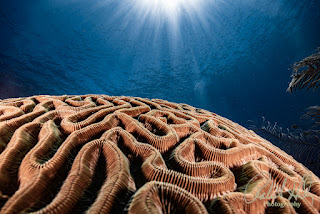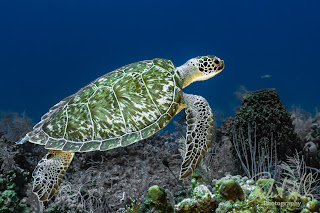Using the Histogram to Perfect Underwater Exposure
Underwater photography presents unique challenges, especially regarding exposure. From uneven lighting to color distortion caused by water, achieving a balanced exposure is crucial to capturing stunning underwater images. One of the most powerful tools for mastering this is the histogram. In this post, I'll guide you through using the histogram in Adobe Lightroom to fine-tune your underwater photos, ensuring optimal exposure and preserving every detail.
Understanding the Histogram
The histogram is a graphical representation of the tonal
values in your image. It divides the tones into five main sections:
- Blacks:
Representing the darkest tones, found on the far left.
- Shadows:
Slightly brighter dark areas, just right of the blacks.
- Midtones:
The middle section represents evenly balanced tones.
- Highlights:
Brighter areas are located right of the midtones.
- Whites:
The brightest tones, represented on the far right.
In Adobe Lightroom, the histogram is located at the top of
the Develop module. You can use the shortcut D to access this module
quickly. Monitoring the histogram helps ensure no details are lost due to
overexposure (clipped whites) or underexposure (clipped blacks).
Step 1: Reading the Histogram
Learning to interpret the histogram is your first step
toward mastering exposure adjustments. Let's break it down:
Example 1: Overexposed Sunlit Scene
An image of a sunlit coral reef might show spikes on the
right side of the histogram (highlights and whites).
- Use
the Highlights slider (shortcut: Shift+H) to pull back
bright tones.
- Adjust
the Whites slider (shortcut: Shift+W) to refine the
brightest areas further.
Example 2: Underexposed Shipwreck
A dimly lit shipwreck might have a histogram leaning heavily
toward the left (blacks and shadows).
- Increase
the Exposure slider (shortcut: Shift+E) to brighten the
overall image.
- Use
the Shadows slider (shortcut: Shift+S) to recover details in
darker areas.
Example 3: Balanced Open-Water Shot
A well-exposed image will display a histogram with an even
spread of tones. If needed:
- Use Auto
Tone (shortcut: Shift+Ctrl+U on Windows or Shift+Cmd+U on
Mac) to start with a balanced adjustment.
- Fine-tune
each slider to enhance specific areas.
Step 2: Using Clipping Indicators
Lightroom's clipping indicators highlight areas where detail
is lost. To activate them, click the triangles in the upper corners of the
histogram or press J on your keyboard.
- Red
areas indicate clipped highlights (overexposure).
- Blue
areas show clipped shadows (underexposure).
Example 4: Highlight Clipping in a Sunburst
A sunburst through the water may show red clipping. To fix
this:
- Lower
the Highlights slider until the red disappears.
- Reduce
the Exposure slider if needed, ensuring the sunburst remains
detailed but not overly bright.
Example 5: Shadow Clipping in a Cave Dive
A cave dive photo may show blue clipping in the shadows.
- Increase
the Shadows slider to recover detail without losing the scene's mood.
- Adjust
the Blacks slider (shortcut: Shift+B) to fine-tune the
darkest areas.
Step 3: Leveraging Lightroom's AI Tools
Modern Lightroom features AI-powered tools that simplify
exposure corrections:
- Auto
Tone: Quickly provides a balanced starting point for adjustments.
- Masking
Tool: Automatically selects specific areas (e.g., a diver, coral, or
background water) for targeted edits. Use the shortcut Shift+M to
activate masking.
Example 6: Isolating a Diver for Local Adjustments
In a photo where a diver's suit appears too dark:
- Use
the Select Subject masking option to isolate the diver.
- Increase
the Exposure and Shadows sliders within the Mask to bring
out details.
Example 7: Enhancing the Water Column
For wide-angle shots where the water appears flat:
- Use
the Select Sky/Water Mask to isolate the water.
- Apply
the Dehaze slider (shortcut: Shift+D) to add depth and
clarity.
Step 4: Fine-Tuning with the Tone Curve
The Tone Curve panel allows for precise tonal adjustments.
You can manipulate the highlights, lights, darks, and shadows directly.
Example 8: Boosting Midtones in a Coral Reef
A coral reef photo with dull midtones can benefit from:
- Adding
a gentle S-curve in the Tone Curve panel.
- Dragging
the midtone point slightly upward for added vibrancy.
Example 9: Creating Drama in a Wreck Scene
For a dramatic effect on a shipwreck:
- Lower
the shadows and blacks in the Tone Curve.
- Increase
highlights to emphasize light streaks.
The histogram is a crucial tool for underwater photographers, vital in image editing and enhancement. Understanding how to read and adjust the histogram can help ensure that your photographs maintain detail and effectively showcase the stunning beauty of the underwater environment. Whether addressing issues with underexposure in a reef scene or striving to achieve the perfect balance with a vibrant sunburst, utilizing Lightroom’s histogram and its advanced editing tools can significantly improve your results.
Experimenting with various techniques while allowing the histogram to inform your adjustments is beneficial. Sharing your outcomes or
seeking guidance in the comments section is encouraged, and you can also reach
out via email at bob@robertherb.com. Elevate the quality of your underwater
photography and make your images stand out!
Happy diving and editing,
Bob
Written by Robert Herb – empowering underwater photographers to capture and enhance the beauty of our oceans.
Stay Connected
Follow my blog for more tips and tutorials on underwater photography. Let's dive deeper into the art and craft of capturing the marine world!
Subscribe to my blog for more tips and tutorials on underwater photography. Remember to share your processed photos on social media using the hashtag #RobertHerbPhotography. I look forward to reviewing your results.
New Online Training Program
I am excited to announce that I am creating an online training program to teach underwater hobbyists and enthusiasts how to enhance their photos using Adobe Lightroom. If you are interested in this training or need more information, please go to (Underwater Photo Training) or contact me at bob@robertherb.com to express your interest and to be notified about the details and start date of the classes.
Stay tuned and "Follow" for upcoming blogs on underwater photography tips and tricks for more in-depth insights. Please leave your comments and suggestions. Enjoy your diving and shooting experience!
I am eagerly anticipating your valuable feedback and suggestions.
Sincerely,
Bob Herb
|
|





Comments
Post a Comment
Please let me know your comments.